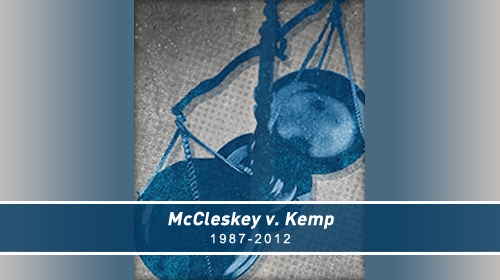
By Diann Rust-Tierney
April 22 marked the 25th anniversary of the Supreme Court decision in McCleskey v. Kemp, in which the Court ruled that a defendant cannot rely upon statistical evidence of systemic racial bias to prove his death sentence unconstitutional, no matter how strong that evidence may be. McCleskey has been roundly condemned as a low point in the quest for equality that begs to be revisited. To mark the occasion, last week the ACLU Blog of Rights featured a new post about McCleskey and its legacy. You can read all the posts here, and visit mccleskeyvkemp.com to learn more.
When the Supreme Court decided McCleskey v. Kemp in 1987, I had been serving as a legislative counsel for the Washington Office of the American Civil Liberties Union for almost two years.
Being a relatively new lawyer in the field, I made it my business to learn capital punishment jurisprudence. It was my goal to be as conversant in the details of the law as my counterparts in capital defense. It was in that context that I came to understand McCleskey v. Kemp. I read all of the briefs and court documents. I was convinced that we would win.
“If the Justices live in the world” I said to myself, they will see the pattern of racially biased sentencing for what it is. After all, the Court had been presented with the most sophisticated and comprehensive study of racial bias in capital sentencing that had ever been conducted. The NAACP Legal Defense Fund’s brief on the history of racial bias in sentencing presented a compelling case of how deeply entrenched racial bias has been and continues to be in the law.
However, evidently the Justices did not live in the world. Maybe they lived in the world too much. They refused to grant Warren McCleskey relief even though they agreed, for the sake of argument, that he had demonstrated a biased pattern of sentencing. They were deterred by the fact that the death penalty, at the time, enjoyed the support of the public.
The silver lining in the case we called the Dred Scott decision of our time was that it directed those appalled by the decision to take their case to the legislature. This was not a matter for the Court, the Justices opined, but one for policymakers.
The Court’s decision in McCleskey provoked outrage in the civil rights community and indeed launched our multiyear campaign to seek redress in Congress. The House of Representatives twice passed legislation known as the Racial Justice Act which would have provided a federal remedy for a racially identifiable pattern of sentencing that could only be explained by discrimination. The measure came within 10 votes in the Senate. It was stopped repeatedly by a bipartisan block of Southern senators who insisted that a federal nondiscrimination standard would mean the end of the death penalty in their states.
Warren McCleskey was executed September 25, 1991.
Fast-forward to last Friday, when on the eve of the anniversary of the McCleskey v. Kemp decision, the North Carolina Racial Justice Act resulted in groundbreaking relief for a death row prisoner who demonstrated that his sentence was the product of racial bias. Among other evidence was a study using the very methodology for demonstrating bias pioneered by the late Professor David Baldus in Warren McCleskey’s case.
I mark this anniversary with a sense of vindication and hope. It is true that the arc of history is long and it does bend toward justice. We see that as the anniversary of the McCleskey v. Kemp case and the landmark decision in the North Carolina Racial Justice Act case literally come full circle.
Diann Rust-Tierney is executive director of the National Coalition to Abolish the Death Penalty and former director of the ACLU Capital Punishment Project.
Learn more about race and the death penalty: Sign up for breaking news alerts, follow us on Twitter, and like us on Facebook.


